Since the beginning of commercial operation of television broadcasting in the late 1930s, television broadcasting has become one of the focuses of human families. According to statistics, the average time for watching TV programs per person per day is about 3-4 hours. In addition to entertainment features, television programming is also an important source of education, knowledge, news and information. Despite the gradual popularization of computers and broadband networks, for most people, the popularity and convenience of TV broadcasting still has its unshakable position. Scientific and technological progress has led to continuous breakthroughs in TV broadcasting-related technologies. Broadcast signals have moved from analog to digital; thin and short precision electronics, allowing users to watch TV at any time is no longer a distant dream. This article takes Lianyang Technology (ITE) AT9050 series chip as an example to discuss how to implement DVB-T digital TV reception on mobile phones, personal navigation devices (PNDs) or portable media players (PMPs).
This article refers to the address: http://
What is analog TV and digital TV?
There are three main types of TV program broadcasts: satellite, cable, and Terrestrial. Terrestrial is the most feasible and cost-effective to support mobile reception, so the following will focus on wireless TV.
Refer to Figure 1 for a traditional analog TV system. The original image obtained by the camera is converted (optical image->RGB->YUV->Composite) and broadcast to the mass through the TV tower. The user receives the wireless signal from the antenna and presents the original portrait on the television. In addition, analog TV has three main formats: NTSC, PAL and SECAM depending on its video format and modulation.

Compared with analog TV, the video data of the digital TV system will be digitized by A/D first, and then compressed by the decoder into MPEG-2 or H.264 code stream. Audio signals have similar processing and will not be described again. Because the digital TV channel can transmit multiple audio and video programs at the same time, a multi-taplex (Multiplex) composite multi-channel program becomes a Transport Stream, and then transmitted through Channel Coding and modulation. The TV at the receiving end must have the ability to demodulate the digital TV radio wave and the MPEG code stream to display the digital program on the TV screen. Traditional analog TVs can watch digital TVs with a Set Top Box.
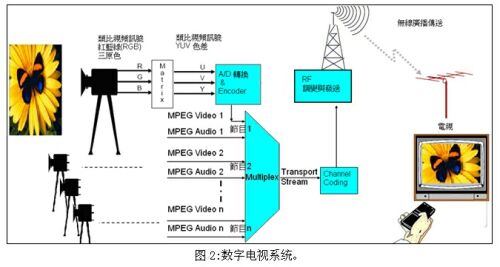
Currently, there are four different specifications for terrestrial wireless digital television systems worldwide, namely DVB-T (EU-led), ATSC (US-led), ISDB-T (Japan-led), and D-TMB (China-led). Among the four specifications, DVB-T is currently the most widely used worldwide. The market size of related industries is also the most optimistic. Please refer to Figure 3.
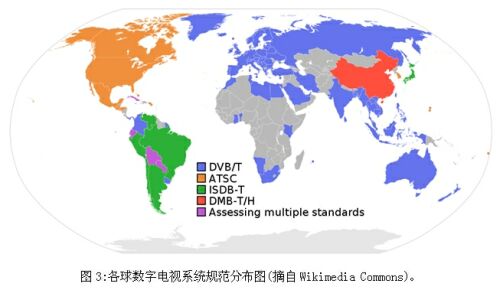
As can be seen from Table 1, digital TV has an overwhelming advantage. Although in most countries except Europe, the United States and Japan and a few advanced countries, the digitization process is faltering due to economic or political reasons, it is an inevitable trend in the world to turn off analog TV to play digital TV.
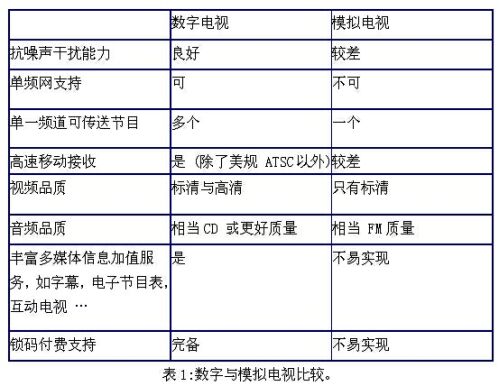
Key issues facing mobile TV design
Implementing TV functionality on mobile devices such as cell phones, personal navigation devices (PNDs) or portable media players (PMPs) faces several key design challenges and issues.
1. Power consumption and heat dissipation
Mobile devices (except vehicles) are mostly battery-powered, and one of the keys to successful low-power design is to extend battery life. Typical products should be able to continue to watch TV for more than 3 to 6 hours on battery power. Heat dissipation and power consumption are two-sided problems. The heat generated by high power consumption will make the heat dissipation mechanism of light and short mobile devices more complicated and cost difficult to control. In general, the power consumption of the TV module part should be controlled below 400mW.
2. Mobile reception
Mobile reception refers to the user watching TV on a vehicle. It is generally hoped that the highway will be able to receive smoothly on the expressway (at least 100 km/h). In wireless reception, when there is relative movement between the receiving end and the transmitting end, there is a Doppler effect, which causes the receiving frequency to shift, so the receiving device must be able to compensate for the Doppler effect. Difference value. (When the relative speed is 120kM/hour, when the receiving frequency is 666MHz, the Doppler effect frequency offset is about 266kHz.)
Taking DVB-T as an example, if the signal is 16QAM coded (such as Taiwan and Germany), the demodulation chip with good mobile reception capability should be able to support more than 120 kilometers per hour with a single antenna. If the signal is encoded in 64QAM (such as France and Italy), it must be designed with a dual antenna to receive good.
3. Receiving dead ends
In most countries, digital TV is still in its infancy, or even just pre-test, so the signal coverage is not complete. Therefore, improving the receiving sensitivity to overcome the reception dead angle is an important topic in the design of wireless television, especially for the mobile market. Mobile devices are only equipped with small antennas, but users may be in a harsh receiving environment (such as the first floor or the basement), so the device must have good receiving sensitivity and expand the availability of the device area to attract more users.
For the current tuner technology, DVB-T signal 64QAM, CR: 7/8, GI: 1/32 as an example can support up to -80dBm or more, and LNA can even go to -82dBm~-83dBm.
With the closure of analog TV, the digital TV tower is expected to broadcast at a higher power, and with the construction of more relay stations, it is believed that the problem of receiving dead ends in the future will no longer exist.
4. Processor capability
The digital television signal is demodulated into an MPEG-2 or H.264 transport stream. The general mobile device processor, except for a few self-contained hard-dissolving functions, cannot completely unpack the standard-definition program content in a soft solution (D1: resolution 720x576, 25 frames per second). Some processors' soft solution schemes claim to play D1, but they are implemented at the expense of resolution or frame loss. When the screen is large or the program code rate is high, it is obvious that the picture quality and fluency are greatly reduced.
For devices that support European DVB-T TV decoding, the program content uses MPEG-2 compression, resolution 720x576, 25 frames per second, and the processing stream rate can reach 7Mbps or more.
5. TV module size
Portable devices are light and thin. If the integration of chips supporting TV functions is not high enough, or the chip size is too large, it will be very difficult to increase the TV function in a limited space. Ideally, the footprint of the TV module portion is preferably less than 20 x 25 square millimeters.
After understanding the above potential design challenges and key issues, the feasibility of the solution can be objectively evaluated when selecting a solution.
Introduction to Lianyang Technology (ITE) AT9050 Series Chips
AT9050 series chip is the latest high-integration DVB-T TV demodulation and decoding single chip (SOC) launched by Lianyang Technology (ITE) at the end of 2008. It is also the world's first DVB tailor-made for portable TV equipment. -T single chip product line. According to the size of the package and embedded memory, the AT9050 series includes AT9056, AT9057, AT9058M and AT9059M, as shown in Figure 4.
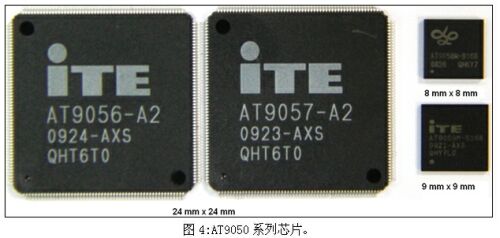
Refer to Figure 5: Block diagram of the AT9050 series chip. The AT9050 series includes: (1) Lianyang Technology's latest generation of high-performance DVB-T demodulator (DVB-T Demodulator), which supports high-speed mobile reception and dual antenna diversity. (2) MPEG-2 decoding hardware, fully supports D1 standard definition (resolution 720x576, 25 frames per second) video decoding, the code rate is more than 7.5Mbps. (3) Audio DAC, which can directly output analog line-out audio signals. (4) Video processor: Contains high-performance 2D graphics engine, Scaler and Deinterlacing; supports various RGB or YUV outputs, can be directly used to push LCD screen, TV encoder, or camera input interface (RGB or CCIR-601/ 656). (5) CPU: 32-bit RISC CPU supports MPEG and AC3 audio decoding and processing DVB-T related middle layer software (Middleware), such as sweeping table, EPG, TeleText, subtitles and so on. (6) Memory: AT9058M and AT9059M embed 8MB or 16MB memory, the system does not need external memory.
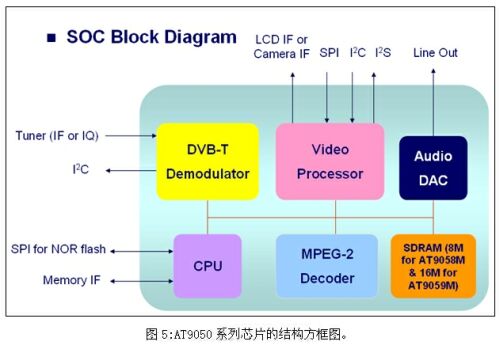
In addition, the AT9050 series chip has extremely low power consumption and is equipped with a power-saving tuner. The entire TV module consumes about 300 to 350 mW, making it ideal for portable devices. Table 2 summarizes the features and features of the AT9050 series.
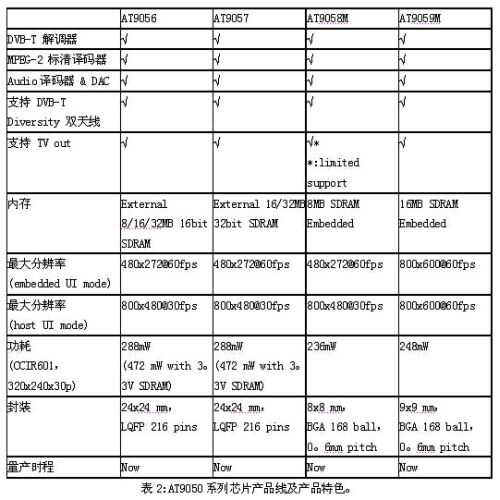
Application Lianyang Technology AT9050 Series Chip Hardware Reference Design
The AT9050 series DVB-T chip is very similar to the widely used YUV/RGB format CMOS sensor camera, so if you want to integrate digital TV reception on mobile portable devices such as mobile phones, GPS, PMP, etc., The user's hardware and software platform can support YUV/RGB format cameras, and has the ability to integrate digital TV reception. The basic concept of integration is to let the video data of the AT9050 series DVB-T TV flow through the original camera process, and then add audio stream processing and I2C (or SPI, UART) control functions. The user can also treat the digital TV module as a special "camera" with audio output.
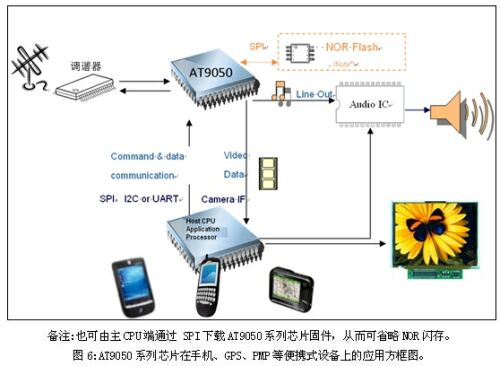
Let's take a typical design as an example to discuss how to use the AT9058M/9059M chip to implement DVB-T function on a portable device. The circuit diagram is shown in Figure 6. According to this reference design, the circuit is divided into several functional blocks for further analysis.
1. System power, reset, and reference clock
The AT9058M/9059M itself requires three sets of power supplies: the core (IVDDx) power supply 1.2V, the embedded SDRAM memory (MOVDD) power supply 1.8V and the I/O (GOVDDx) power supply 1.8V~3.3V (selected with the application processor). The reference clock can be generated by a separate oscillator or directly referenced to the tuner's clock. The AT9050 series reference clock is determined by pin striping and can be flexibly selected from 8.192MHz to 36MHz. After the power supply and the reference clock are stable, the reset pin is pulled low for 10ms to reset the chip core. In general, the power on/off and reset pins are connected to the GPIO pins of the application processor and are controlled by software.
2. Tuner, LNA and GSM filter
The AT9050 series of chips can support a variety of tuners, and users can choose the right solution based on the price/performance and power consumption of different tuners. The core power of each manufacturer's tuner is different. It should be noted that the tuner requires extremely high quality of the power supply, so it is best to have a separate power supply (not to be connected to the IVDDx/MOVDD/GOVDDx of the AT9050 series).
If the reference clock for the AT9058M/9059M comes from the tuner, the tuner reset time point is earlier than the AT9058M/9059M reset time point to ensure a stable reference clock when the AT9058M/9059M is reset.
Some tuners offer LNA options to increase reception sensitivity. In addition to increasing cost and power consumption, adding LNA should also consider whether the system's ability to isolate adjacent-channel interference and the received signal-to-noise ratio are affected.
If it is the design of the mobile phone, it should also consider whether it should be added to the GSM rejection filter. The communication frequency of GSM mobile phones has two frequency bands of 900MHz and 1,800MHz. If the cell phone communication at the place where the mobile phone is sold uses the 900MHz band, consider adding a GSM reject filter. 900MHz and DVB-T's highest frequency point 858MHz is too close, which will cause interference of program reception near high frequency, and too strong GSM RF signal may also cause strong signal saturation and even damage the tuner.
The tuner is susceptible to internal or external electromagnetic interference and affects performance. It is necessary to reserve the spacer space. The AT9050 family of chips has a dedicated set of I2Cs for controlling the tuner.
3.NOR flash
The AT9058M/9059M needs to load firmware before running. The firmware of different configurations is different. Generally, 2MB or 4MB serial NOR flash is enough. In addition to loading firmware from serial NOR flash, you can also choose to load from the application processor via the control interface (I2C or SPI). However, consider whether it is acceptable to control the interface performance and the time required to transfer the entire component (about 2M~4MB).
4. Control interface
The application processor can control the AT9058M/9059M via SPI, I2C or UART. The reference design shown in Figure 6 is based on I2C. I2C is a one-to-many control bus. Except that the application processor is the master device, there can be multiple slave devices on the same bus. Therefore, pay attention to the possibility of interference from each other between devices. The UART and SPI interfaces are one-to-one, and the bus problem is relatively simple. Interface transmission performance is another issue to consider. The AT9050 series chip SPI can support up to 25Mbps, the UART is 921Kbps, and the I2C is 400Kbps.
5. Camera video data bus
The AT9058M/AT9059M supports a variety of video data bus formats such as CCIR-601, CCIR-656 or RGB. Since the video data bus of the portable device may be shared by the AT9058M/AT9059M with one or more cameras, it is preferable to use the same video data bus format considering the convenience of the application processor driver software. If multiple devices share the data bus, pay special attention to I/O voltage consistency and output pin load issues (note that the video data voltage reference may be pulled low by other devices).
When transmitting high-resolution video on the data bus, it is easy to generate EMI problems (AT9050 series chip video data clock can be up to 27MHz or more), it is best to reserve EMI filter.
The camera video data bus of the general application processor will provide the camera working clock. The AT9058M/AT9059M is not needed, so it is not necessary to connect. AT9050 series chip video output is highly flexible, progressive or alternate scanning, different resolutions (including 320x240, 480x272, 640x480, 720x480, 800x480 or 720x576), different frame rates (1fps~60fps, H-sync/V-sync polarity) And timing, YUV range (standard or extended), etc. can be controlled by software, thus ensuring perfect integration on the camera interface of different platforms.
6. Audio signal
The AT9050 series chip has a built-in audio DAC that directly outputs the decoded stereo analog line (Line-out). The sound signal should be connected to the system's audio processing IC (responsible for sound amplification, volume control and mixing). The reference design of Figure 6 assumes that the application processor has its own audio processing function, so the AT9058M/9059M audio output is directly connected to the application processor.
7. Boot configuration (Strapping)
Some of the operational configurations of the AT9050 family of chips are determined by the voltage levels of certain pins at system reset, such as UR0_RI and UR0_DCD.
UR0_RI: Firmware loading method
0: NOR Flash boot, loading firmware by Serial NOR Flash
1: Host boot, loaded from the application processor through the control interface
UR0_DCD: Control interface category
0: I2C
1: SPI
8. Dual antenna diversity design
In order to support the dual antenna, a Lianyang Technology AF9033 and tuner must be added. The reference clock required for the AF9033 must be provided by the AT9050 series chip CLK_out. The AT9050 series chip also has a dedicated I2C to control the AF9033. In addition, the two antennas (center points) should be placed at least 30 cm apart for optimum performance. Dual antennas can improve reception sensitivity and mobile reception, but also pay attention to the increase in power consumption and the limitation of antenna placement.

System software integration
Because digital TV provides more data services than analog TV, such as electronic program schedules, TeleText, subtitles, etc., the software is relatively complex. Fortunately, the AT9050 family of chips supports these features in the middle-tier software of the internal firmware. For application processor applications, it is only necessary to perform some simple tasks, including chip initialization, displaying camera video data on the screen, and passing user input (hot keys or touch screen information) to the AT9050 series chips.
As shown in FIG. 7, the software package on the application processor user platform side includes "TV Controller", "Bus Driver", and "9050 API Library". Among them, "9050 API Library" is the source code provided by Lianyang Technology, and only "TV Controller" and "Bus Driver" need to be implemented on the target platform. The "TV Controller" can easily initialize and control the AT9050 series chips by calling less than 10 API functions.
Lianyang Technology also provides "TV Controller" and "Bus Driver" reference source code on Windows XP, Windows CE and Linux to facilitate developers to migrate to different platforms in the shortest time.
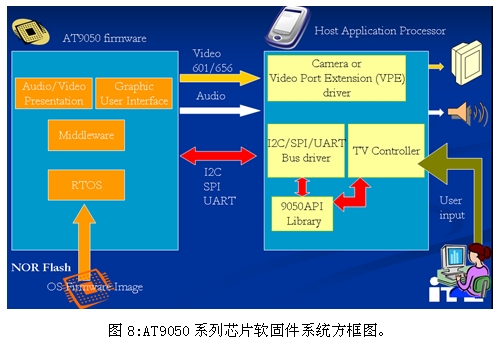
Summary of this article
Lianyang Technology AT9050 series is a highly integrated, advanced chip with integrated functions and complete software support. Integration vendors can have DVB-T TV reception capabilities by making modifications to existing portable device designs. It is believed that portable devices with TV functions will become popular in the future.
Yuhai company is engaged in produce high performance Piezoelectric Elements,
Piezoelectric Rings For Ultrasonic Machining
Piezo parts of Ultrasonic cutting
Zibo Yuhai Electronic Ceramic Co., Ltd. , https://www.yhpiezo.com
